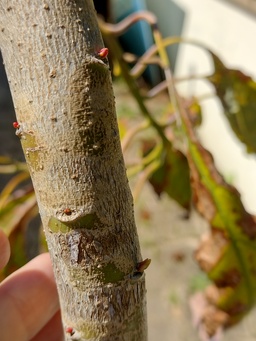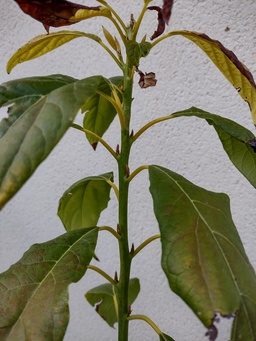Blog: Spring is here
May 1, 2025
Well, winter is definitely over now. Our last frost date was March 17th, so more than 6 weeks ago. Everything has woken up and started growing like crazy. However, it wasn’t entirely without drama.
The freeze of March 2025

The last two weeks of February and the first two weeks of March had no freezes at all. Around this time, I reasoned that it was not going to be very long until the growing season would start up again, and that therefore, I should try to wind down the cold protection measures to potentially allow some damage in order to see how hardy the trees actually are.
On the morning of the 14th of March we had a -0.9°C freeze. I can’t say it was entirely unexpected but I will admit that I forgot about having moved some trees completely out of the plastic greenhouse. And so, some things got tested a bit harder than I had planned. Luckily, nothing was killed.
The trees that sustained the most damage were: tree no. 2, tree no. 3, tree no. 4, and tree no. 5, as they had stayed inside the greenhouse for all the previous frosts and freezes.
Tree no. 1, like most of the trees, had a few of its top leaves fried, but essentially all the lower foliage that had otherwise survived the winter took little to no new additional damage.
Deaths
Although nothing was killed in by the last freeze, I did sadly have 4 deaths over the course of the winter: tree no. 9, tree no. 11, tree no. 17, and tree no. 23. RIP.
Cause of death? Unclear. All of these survived to the start of December but were already in decline by then and were moved indoors to nurse them back to health. Alas, that did not work. I suspect there was something else wrong.
Winn (of drymifolia.org) pointed me to a paper, “Outcrossing between ‘Bacon’ Pollinizers and Adjacent ‘Hass’ Avocado Trees and the Description of Two New Lethal Mutants” (R.J. Schnell et al., 2009), where they found that around 11% of Hass seedlings, due to being selfed, have a deadly mutation leading to spindly growth and decline and death within a few months. This would be consistent with my experience: 4 out of my ~43 Hass seedlings is roughly 9%. I’m taking this with a pinch of salt as there are many other possible explanations (and many uncontrolled variables, such as the pollenizer varieties used where these seeds came from), but the description of the decline and the numbers definitely seem to match.
Survivors
The trees that died back to the roots in the January freeze, tree no. 34, tree no. 37, tree no. 38, and tree no. 39, have all recovered quite nicely with lots of new foliage – most with multiple new stems.
These trees were all planted around the same time and stood together on a different side of the house from most of the other trees, but I suspect that their young age was the main factor: they were planted in September and most of the seeds planted after this (and left outside) did not produce a stem before the weather cooled down significantly. My conclusion is that it is better not to germinate or plant seeds after around mid-August, at least not if the trees are supposed to stay outdoors. I did plant many “Wild Mexican” seeds after September (and during winter), but they were all well protected (e.g. in the greenhouse).
I’d also like to point out a few trees that either seemed to take the cold really well or look remarkable in some way:
- tree no. 33 (seedling of Insana, from Spain): stayed in the greenhouse during winter; showing very healthy foliage.
- tree no. 30 (seedling of Hass, from Colombia), tree no. 28 (seedling of Hass, from Peru), and tree no. 26 (seedling of Hass, from Peru): stayed outside under a polycarbonate sheet and showing very little cold damage.
- tree no. 32 (seedling of Hass, from Colombia): had its leaves fried at the end of December, was moved indoors, and is now recovered with 4 new healthy branches.
- tree no. 24 (seedling of Fuerte, from Spain): remarkably little cold damage compared to other trees that were close to it under the polycarbonate sheet.
- tree no. 48 (“Tropical”): this tree stayed in a cold (but not freezing) room over the winter and grew giant leaves after moving outdoors, bigger than any other tree I have.
As a general observation, I think the Fuerte seedlings do show a little more cold tolerance than many of the Hass seedlings, but they definitely also took some damage.
New growth

The last two weeks of April have shown a lot of new growth. I was especially happy to see tree no. 1 wake up and produce tiny red dots all along its main stem and branches – dormant epicormic buds. These buds are now just starting to leaf out. I can’t wait to see this tree with more foliage again; this tree was grown indoors for four years and only moved outside at the end of June. As a result, even though it did grow a lot outside at the end of summer compared to how it grew indoors, it did not really have the time to acclimatize or harden off most of its leaves before winter. This year I’m hoping a full growing season outdoors will really allow this tree to take off.

Most, if not all, of the other trees are showing signs of new buds, new shoots, or new leaves. One thing that is probably obvious to experienced growers but which still surprises me a little is how the growth differs depending on whether the terminal shoot died or not: the trees where the main stem or terminal shoot died back have new buds leafing out all the way down along the stem, whereas those that kept their terminal shoot continue to grow only from the top, even after winter dormancy.
It’s still very early in the growing season, but I am fairly confident that we’re past the last frost for this winter and I really can’t wait to see how these trees develop in their second year.
New seeds
On February 18th I received 8 seeds from various locations from belinsecte (of fruitforestier.info/). These seeds were collected from mature, non-Hass trees that are growing in marginal locations, so these seeds have a lot of potential in terms of cold hardiness.
As of today, 7 of these have germinated and were planted, but have not yet produced any shoots: tree no. 109, tree no. 110, tree no. 111, tree no. 112, tree no. 113, tree no. 114, and tree no. 116. The last seed was compromised and I think the embryo is dead, although the seed itself is still creamy so I’m still holding out for an eventual germination.
I also had the opportunity to buy Bacon avocados (and I discovered that I really love their mild flavour) so I also have 7 seeds from Bacon avocados that have germinated but yet produced any stems and a few more seeds waiting to germinate.
In total, I still have 29 seeds waiting to germinate as of this moment, but I will probably slowly transition to planting seeds directly in the ground (or moving some of the sprouted seedlings into the ground) as I will soon be running out of capacity to water every tree individually.
I did actually already plant a few seeds from supermarket Hass fruit directly in the ground and at least one of them has produced a stem; however, I think snails and slugs might have gotten to it as it looks like the tender first leaves have been eaten up. I will still keep an eye on it, of course. These seeds are not yet numbered or tracked, but I will create pages for them if they survive beyond the very first stages of growth.
Website updates
I photographed and tagged essentially all of the trees and added them to the individual tree pages; feel free to check out the updated trees page, which shows all of them.
I fixed a number of issues with the website rendering on mobile/smartphones.
I added preview cards to all of the tree pages so that sharing tree links on social media now shows a preview card with the latest picture of each tree.
